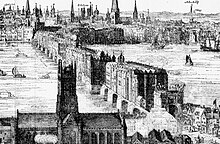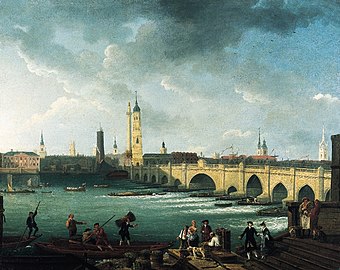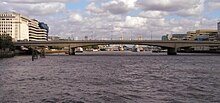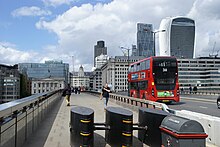London Bridge Improvement Act 1756
The current bridge stands at the western end of the Pool of London and is positioned 30 metres (98 ft) upstream from previous alignments. The approaches to the medieval bridge were marked by the church of St Magnus-the-Martyr on the northern bank and by Southwark Cathedral on the southern shore. Until Putney Bridge opened in 1729, London Bridge was the only road crossing of the Thames downstream of Kingston upon Thames. London Bridge has been depicted in its several forms, in art, literature, and songs, including the nursery rhyme "London Bridge Is Falling Down", and the epic poem The Waste Land by T. S. Eliot.
The modern bridge is owned and maintained by Bridge House Estates, an independent charity of medieval origin overseen by the City of London Corporation. It carries the A3 road, which is maintained by the Greater London Authority. The crossing also delineates an area along the southern bank of the River Thames, between London Bridge and Tower Bridge, that has been designated as a business improvement district.
History
Location
The abutments of modern London Bridge rest several metres above natural embankments of gravel, sand and clay. From the late Neolithic era the southern embankment formed a natural causeway above the surrounding swamp and marsh of the river's estuary; the northern ascended to higher ground at the present site of Cornhill. Between the embankments, the River Thames could have been crossed by ford when the tide was low, or ferry when it was high. Both embankments, particularly the northern, would have offered stable beachheads for boat traffic up and downstream – the Thames and its estuary were a major inland and Continental trade route from at least the 9th century BC.
There is archaeological evidence for scattered Neolithic, Bronze Age and Iron Age settlement nearby, but until a bridge was built there, London did not exist. A few miles upstream, beyond the river's upper tidal reach, two ancient fords were in use. These were apparently aligned with the course of Watling Street, which led into the heartlands of the Catuvellauni, Britain's most powerful tribe at the time of Caesar's invasion of 54 BC. Some time before Claudius's conquest of AD 43, power shifted to the Trinovantes, who held the region northeast of the Thames Estuary from a capital at Camulodunum, nowadays Colchester in Essex. Claudius imposed a major colonia at Camulodunum, and made it the capital city of the new Roman province of Britannia. The first London Bridge was built by the Romans as part of their road-building programme, to help consolidate their conquest.
Roman bridges
It is possible that Roman military engineers built a pontoon type bridge at the site during the conquest period (AD 43). A bridge of any kind would have given a rapid overland shortcut to Camulodunum from the southern and Kentish ports, along the Roman roads of Stane Street and Watling Street (now the A2). The Roman roads leading to and from London were probably built around AD 50, and the river-crossing was possibly served by a permanent timber bridge. On the relatively high, dry ground at the northern end of the bridge, a small, opportunistic trading and shipping settlement took root and grew into the town of Londinium.
A smaller settlement developed at the southern end of the bridge, in the area now known as Southwark. The bridge may have been destroyed along with the town in the Boudican revolt (AD 60), but Londinium was rebuilt and eventually, became the administrative and mercantile capital of Roman Britain. The bridge offered uninterrupted, mass movement of foot, horse, and wheeled traffic across the Thames, linking four major arterial road systems north of the Thames with four to the south. Just downstream of the bridge were substantial quays and depots, convenient to seagoing trade between Britain and the rest of the Roman Empire.
Early medieval bridges
With the end of Roman rule in Britain in the early 5th century, Londinium was gradually abandoned and the bridge fell into disrepair. In the Anglo-Saxon period, the river became a boundary between the emergent, mutually hostile kingdoms of Mercia and Wessex. By the late 9th century, Danish invasions prompted at least a partial reoccupation of the site by the Saxons. The bridge may have been rebuilt by Alfred the Great soon after the Battle of Edington as part of Alfred's redevelopment of the area in his system of burhs, or it may have been rebuilt around 990 under the Saxon king Æthelred the Unready to hasten his troop movements against Sweyn Forkbeard, father of Cnut the Great. A skaldic tradition describes the bridge's destruction in 1014 by Æthelred's ally Olaf, to divide the Danish forces who held both the walled City of London and Southwark. The earliest contemporary written reference to a Saxon bridge is c. 1016, when chroniclers mention how Cnut's ships bypassed the crossing during his war to regain the throne from Edmund Ironside.
Following the Norman conquest in 1066, King William I rebuilt the bridge. It was repaired or replaced by King William II, destroyed by fire in 1136, and rebuilt in the reign of Stephen. Henry II created a monastic guild, the "Brethren of the Bridge", to oversee all work on London Bridge. In 1163, Peter of Colechurch, chaplain and warden of the bridge and its brethren, supervised the bridge's last rebuilding in timber.
Old London Bridge (1209–1831)

After the murder of his former friend and later opponent Thomas Becket, Archbishop of Canterbury, the penitent King Henry II commissioned a new stone bridge in place of the old, with a chapel at its centre dedicated to Becket as martyr. The archbishop had been a native Londoner, born at Cheapside, and a popular figure. The Chapel of St Thomas on the Bridge became the official start of pilgrimage to his Canterbury shrine; it was grander than some town parish churches, and had an additional river-level entrance for fishermen and ferrymen. Building work began in 1176, supervised by Peter of Colechurch. The costs would have been enormous; Henry's attempt to meet them with taxes on wool and sheepskins probably gave rise to a later legend that London Bridge was built on wool packs.
In 1202, before Colechurch's death, Isembert, a French monk who was renowned as a bridge builder, was appointed by King John to complete the project. Construction was not finished until 1209. There were houses on the bridge from the start; this was a normal way of paying for the maintenance of a bridge, though in this case it had to be supplemented by other rents and by tolls. From 1282 two bridge wardens were responsible for maintaining the bridge, heading the organization known as the Bridge House. The only two collapses occurred when maintenance had been neglected, in 1281 (five arches) and 1437 (two arches). In 1212, perhaps the greatest of the early fires of London broke out, spreading as far as the chapel and trapping many people.
The bridge was about 926 feet (282 metres) long, and had nineteen piers, supported by timber piles. The piers were linked above by nineteen arches and a wooden drawbridge. Above and below the water-level, the piers were enclosed and protected by 'starlings', supported by deeper piles than the piers themselves. The bridge, including the part occupied by houses, was from 20 to 24 feet (6.1 to 7.3 metres) wide. The roadway was mostly around 15 feet (4.6 metres) wide, varying from about 14 feet to 16 feet, except that it was narrower at defensive features (the stone gate, the drawbridge and the drawbridge tower) and wider south of the stone gate. The houses occupied only a few feet on each side of the bridge. They received their main support either from the piers, which extended well beyond the bridge itself from west to east, or from 'hammer beams' laid from pier to pier parallel to the bridge. It was the length of the piers which made it possible to build quite large houses, up to 34 feet (10 metres) deep.
The numerous starlings restricted the river's tidal ebb and flow. The difference in water levels on the two sides of the bridge could be as much as 6 feet (1.8 m), producing ferocious rapids between the piers resembling a weir. Only the brave or foolhardy attempted to "shoot the bridge" – steer a boat between the starlings when in flood – and some were drowned in the attempt. The bridge was "for wise men to pass over, and for fools to pass under." The restricted flow also meant that in hard winters the river upstream was more susceptible to freezing.
The number of houses on the bridge reached its maximum in the late fourteenth century, when there were 140. Subsequently, many of the houses, originally only 10 to 11 feet wide, were merged, so that by 1605 there were 91. Originally they are likely to have had only two storeys, but they were gradually enlarged. In the seventeenth century, when there are detailed descriptions of them, almost all had four or five storeys (counting the garrets as a storey); three houses had six storeys. Two-thirds of the houses were rebuilt from 1477 to 1548. In the seventeenth century, the usual plan was a shop on the ground floor, a hall and often a chamber on the first floor, a kitchen and usually a chamber and a waterhouse (for hauling up water in buckets) on the second floor, and chambers and garrets above. Approximately every other house shared in a 'cross building' above the roadway, linking the houses either side and extending from the first floor upwards.

All the houses were shops, and the bridge was one of the City of London's four or five main shopping streets. There seems to have been a deliberate attempt to attract the more prestigious trades. In the late fourteenth century more than four-fifths of the shopkeepers were haberdashers, glovers, cutlers, bowyers and fletchers or from related trades. By 1600 all of these had dwindled except the haberdashers, and the spaces were filled by additional haberdashers, by traders selling textiles and by grocers. From the late seventeenth century there was a greater variety of trades, including metalworkers such as pinmakers and needle makers, sellers of durable goods such as trunks and brushes, booksellers and stationers.
The three major buildings on the bridge were the chapel, the drawbridge tower and the stone gate, all of which seem to have been present soon after the bridge's construction. The chapel was last rebuilt in 1387–1396, by Henry Yevele, master mason to the king. Following the Reformation, it was converted into a house in 1553. The drawbridge tower was where the severed heads of traitors were exhibited. The drawbridge ceased to be opened in the 1470s and in 1577–1579 the tower was replaced by Nonsuch House—a pair of magnificent houses. Its architect was Lewis Stockett, Surveyor of the Queen's Works, who gave it the second classical facade in London (after Somerset House in the Strand). The stone gate was last rebuilt in the 1470s, and later took over the function of displaying the heads of traitors. The heads were dipped in tar and boiled to preserve them against the elements, and were impaled on pikes. The head of William Wallace was the first recorded as appearing, in 1305, starting a long tradition. Other famous heads on pikes included those of Jack Cade in 1450, Thomas More in 1535, Bishop John Fisher in the same year, and Thomas Cromwell in 1540. In 1598, a German visitor to London, Paul Hentzner, counted over 30 heads on the bridge:
On the south is a bridge of stone eight hundred feet in length, of wonderful work; it is supported upon twenty piers of square stone, sixty feet high and thirty broad, joined by arches of about twenty feet diameter. The whole is covered on each side with houses so disposed as to have the appearance of a continued street, not at all of a bridge. Upon this is built a tower, on whose top the heads of such as have been executed for high treason are placed on iron spikes: we counted above thirty.
The last head was installed in 1661; subsequently heads were placed on Temple Bar instead, until the practice ceased.
There were two multi-seated public latrines, but they seem to have been at the two ends of the bridge, possibly on the riverbank. The one at the north end had two entrances in 1306. In 1481, one of the latrines fell into the Thames and five men were drowned. Neither of the latrines is recorded after 1591.
In 1578–1582 a Dutchman, Peter Morris, created a waterworks at the north end of the bridge. Water wheels under the two northernmost arches drove pumps that raised water to the top of a tower, from which wooden pipes conveyed it into the city. In 1591 water wheels were installed at the south end of the bridge to grind corn.
In 1633 fire destroyed the houses on the northern part of the bridge. The gap was only partly filled by new houses, with the result that there was a firebreak that prevented the Great Fire of London (1666) spreading to the rest of the bridge and to Southwark. The Great Fire destroyed the bridge's waterwheels, preventing them from pumping water to fight the fire.

For nearly 20 years, only sheds replaced the burnt buildings. They were replaced In the 1680s, when almost all the houses on the bridge were rebuilt. The roadway was widened to 20 feet (6.1 metres) by setting the houses further back, and was increased in height from one storey to two. The new houses extended further back over the river, which would cause trouble later. In 1695, the bridge had 551 inhabitants. From 1670, attempts were made to keep traffic in each direction to one side, at first through a keep-right policy and from 1722, through a keep-left policy. This has been suggested as one possible origin for the practice of traffic in Britain driving on the left.
| London Bridge Act 1756 | |
|---|---|
| Act of Parliament | |
 | |
| Long title | An Act to improve, widen, and enlarge, the Passage over and through London Bridge. |
| Citation | 29 Geo. 2. c. 40 |
| Dates | |
| Royal assent | 27 May 1756 |
A fire in September 1725 destroyed all the houses south of the stone gate; they were rebuilt. The last houses to be built on the bridge were designed by George Dance the Elder in 1745, but these buildings had begun to subside within a decade. The London Bridge Act 1756 (29 Geo. 2. c. 40) gave the City Corporation the power to purchase all the properties on the bridge so that they could be demolished and the bridge improved. While this work was underway, a temporary wooden bridge was constructed to the west of London Bridge. It opened in October 1757 but caught fire and collapsed in the following April. The old bridge was reopened until a new wooden construction could be completed a year later. To help improve navigation under the bridge, its two centre arches were replaced by a single wider span, the Great Arch, in 1759.
Demolition of the houses was completed in 1761 and the last tenant departed after some 550 years of housing on the bridge. Under the supervision of Dance the Elder, the roadway was widened to 46 feet (14 m) and a balustrade was added "in the Gothic taste" together with 14 stone alcoves for pedestrians to shelter in. However, the creation of the Great Arch had weakened the rest of the structure and constant expensive repairs were required in the following decades; this, combined with congestion both on and under bridge, often leading to fatal accidents, resulted in public pressure for a modern replacement.
-
London Bridge from Pepper Alley Stairs by Herbert Pugh, showing the appearance of London Bridge after 1762, with the new "Great Arch" at the centre
-
Old London Bridge by J. M. W. Turner, showing the new balustrade and the back of one of the pedestrian alcoves
-
One of the pedestrian alcoves from the 1762 renovation, now in Victoria Park, Tower Hamlets – a similar alcove from the same source can be seen at the Guy's Campus of King's College London
-
A section of balustrade from London Bridge, now at Gilwell Park in Essex
-
A relief of the Hanoverian Royal Arms from a gateway over the old London Bridge now forms part of the façade of the King's Arms pub, Southwark
-
The Demolition of Old London Bridge, 1832, Guildhall Gallery, London



















